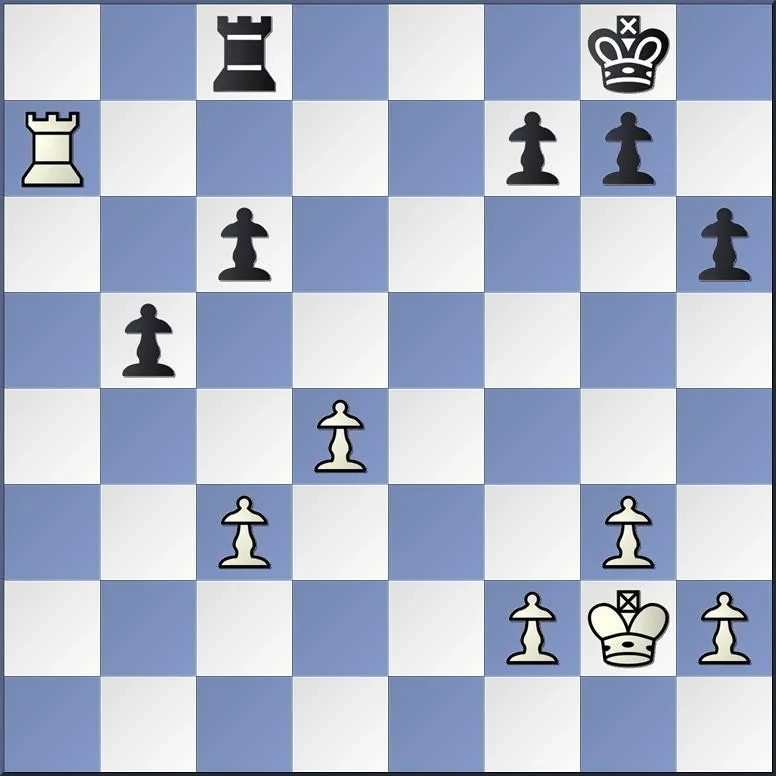Three Storylines to Watch From Shanghai
GM Tan Zhongyi leads four-time defending champion GM Ju Wenjun 1½–½ in Shanghai after two rounds of the 2025 FIDE Women’s World Chess Championship (WWCC).

Tan — who won the 2017 FIDE WWCC before losing her title in a match against Ju a year later — took advantage of Ju’s time trouble in an imbalanced rook-and-pawns endgame to win game 2 on Friday. Play resumes on Sunday, April 6, at 3:00 a.m. EDT (which is 3:00 p.m. local time).

WGM Sabina Foisor will be annotating every game for Chess Life Online. Be sure to “like” our study with her annotations, and check in during the afternoon of each game day to see her detailed, insightful commentary on both the chess match and the underlying psychological battle developing between these two longtime adversaries. Foisor’s full analysis of the first two games is also included at the bottom of this report.
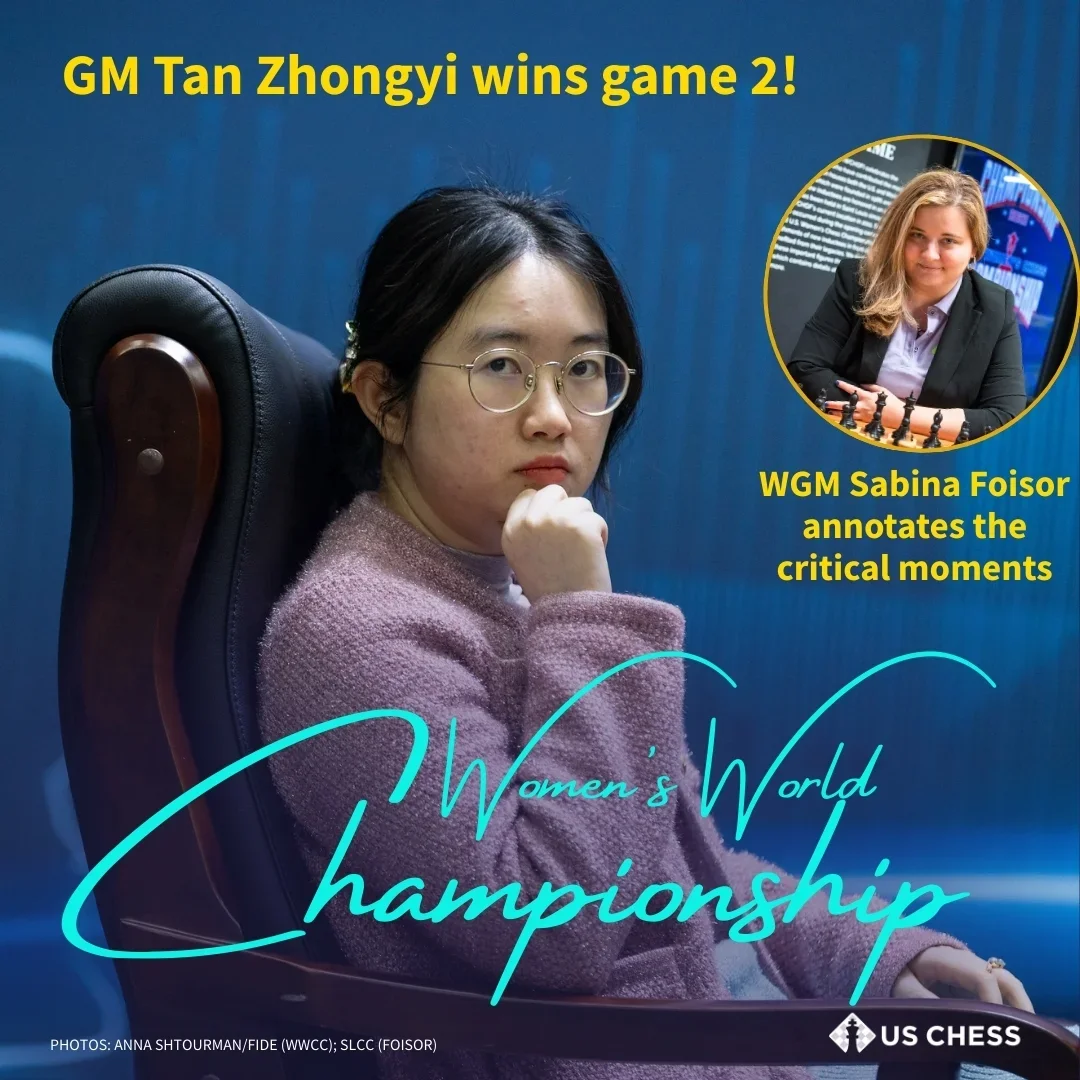
Based on Foisor’s coverage, below are three key themes that jump out from the first two games.
1. Almost Every Principle Has Exceptions
During game 1, Tan faced two key moments as Black where she correctly made a concrete, practical decision at the expense of following conventional wisdom. These choices helped her neutralize Ju’s somewhat surprising choice of 1. e4 without much difficulty.
In the first diagram, Tan flouted the maxim of never playing both … e7-e6 and … g7-g6 in a Sicilian:

By weakening her dark squares in this way, Black must now be prepared for a possible infiltration by White’s dark-squared bishop through numerous diagonals. But, with White having already committed her dark-squared bishop to the f4-square, threats of Bc1-a3 were less pertinent.
Tan correctly assessed that White was unable to exploit her weak color complex, whereas her dark-squared bishop would be well-placed on the long diagonal. White had nothing better than trading it off a few moves later, and the trade of pieces helped Black reach an equal endgame.
In the next diagram (from later in the same game), how would you evaluate the position after White’s 20. cxd5, and would you recapture immediately with … e6xd5, or choose something else?
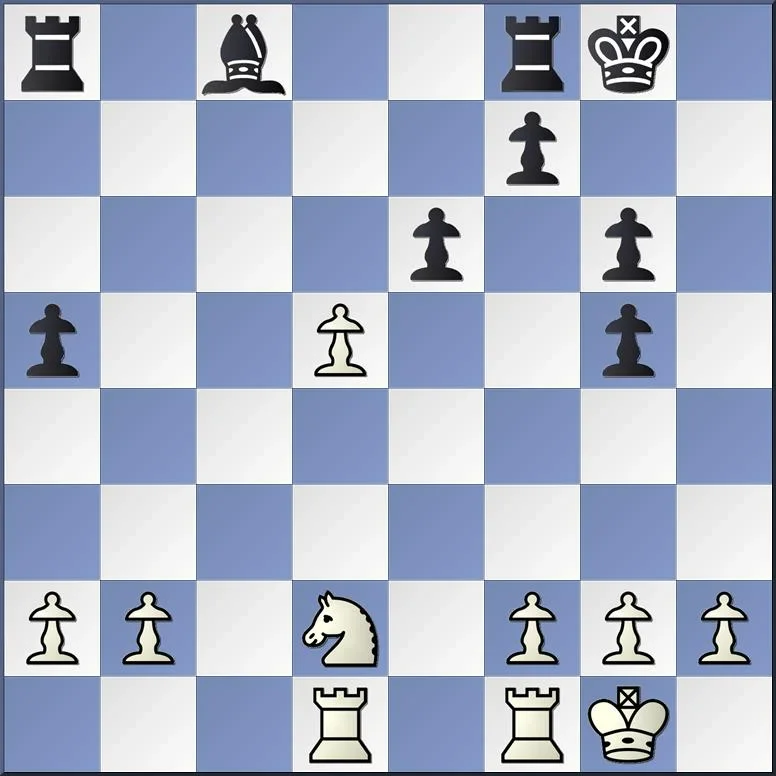
Tan swiftly recaptured, which turned out to be the simplest way to equality. While this is correct, it still feels counter-intuitive for Black to be comfortable in a position with so many pawns stuck on the same color as her lone bishop. Add to that the isolated d5-pawn and White’s threat of Nd2-f3-d4 with a blockade, and it seems like a clear advantage for White that could show up in a book like Simple Chess. Indeed, several experienced grandmasters were surprised by Tan’s decision:
This is an interesting generational clash.
I am also brought up with the idea that black should be really worried if the knight enters d4 here, but the computer says black is just completely fine. https://t.co/xNqtXiXW5Z— Peter Heine Nielsen (@PHChess) April 3, 2025
While this idea of 20. … Rd8 is also equal (according to the engine), Tan’s evaluation was both correct and risk-free. Foisor explains that, “Getting into this position, Ju realized that even if Black has three weak pawns (a5, d5 and g5), putting pressure on them is not easy. Without an outpost, her knight won't be able to show superiority to Black's bishop, either.” Chess isn’t always so simple, after all!
2. Activity Over Material in Rook Endgames
If every principle has exceptions, that includes the principle that every principle has exceptions! There’s no substitute for active rooks in the endgame. While these players are no stranger to the concept of sacrificing a pawn to improve rook position (or king position) in an endgame, it is not always easy to calculate the best way to do so.
In both of the above diagrams, Black should have played … b5-b4 to improve her pieces. In the first diagram, this was the cleanest way to draw. In the second, it was necessary. Foisor discusses both moments in her analysis, but she wasn’t the only one who thought Black made her own life unnecessarily complicated:
Maybe 31...b4 was cleaner, don't see how White presses, 32.cxb Rd8 33.Kf3 Rxd4 34.Rb7 Rc4 35.Ke3 Rc2.
In the second diagram, already 38...Rb3, you can get worried about d5-d6 with no time on the clock.
Maybe 37...Rb3!? 38.d5 Ke8 39.d6 Rf3! was the way.
We keep following.🍿 https://t.co/RukEbu4srh pic.twitter.com/tBs23Pf1Om— Anish Giri (@anishgiri) April 4, 2025
3. The Battle off the Board
As Foisor discussed in her match preview, these two players have a long history. In 2016, Ju was board two and Tan was board three on China’s Women’s Olympiad team that won a gold medal. Ju and Tan were also boards two and four, respectively, on the 2014 team that won silver.
These two former teammates are also close in age (Ju turned 34 in January, while Tan turns 34 next month), meaning they have spent most of their adult lives competing against each other in both national and international competition. Dating back to 2008, they’ve faced off dozens of times in classical games, including their 10-game match in 2018.
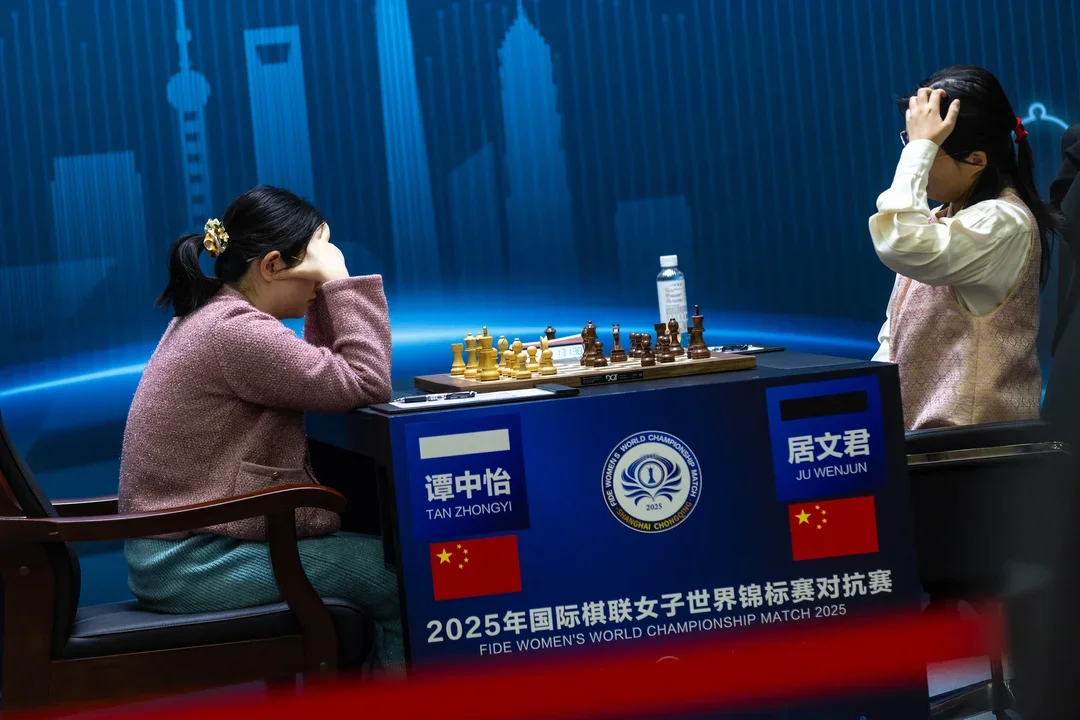
Given this background, it makes sense that psychological factors are already playing a role. For instance, in game 2, Tan had to decide whether she wanted to return to an opening (1. c4) that led to her first loss in her 2018 match. Foisor explains Tan’s decision, observing that, “In my experience when one plays the same player over and over again you start developing this idea of trying to be better than them. I think Tan wanted to show that she isn't afraid of repeating the same opening. Afterall, she didn't lose that game 2 because of the opening. So her mind was made, she was going to play 1.c4 with confidence.”
But psychological factors do not only play a role during preparation. Towards the end of game 2, with Ju suffering from time trouble in an imbalanced position, a lack of objectivity proved fatal.
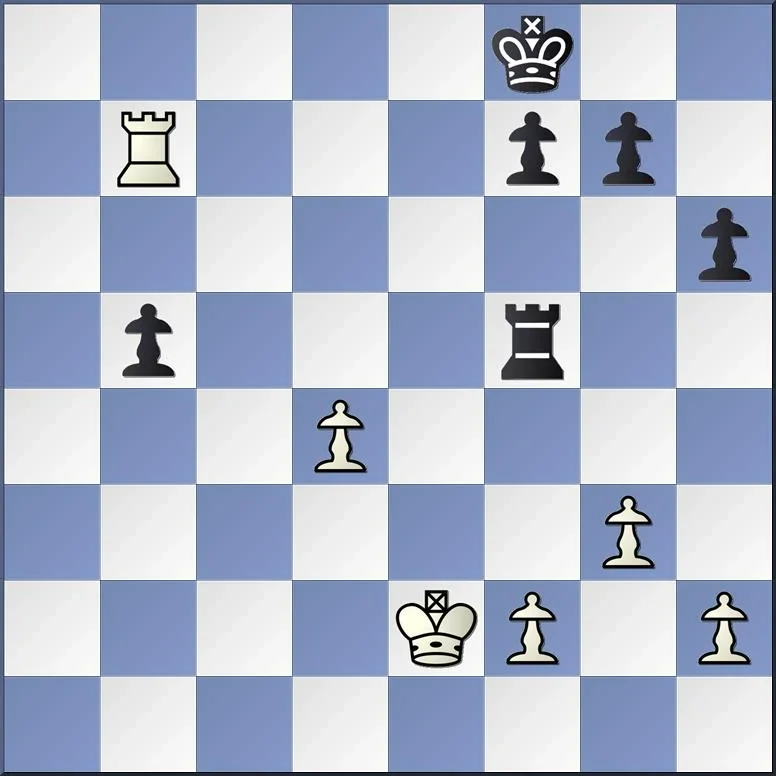
In the lead-up to this decision, Foisor observes that, “Ju may have overestimated her opponent's possibility of making a mistake. It does feel that it is Black who could be slightly better given that the b-pawn is further away, but it is the d-pawn that is more advanced and White's both Rook and king are more active.”
Would Ju feel the same pressure to prove her dominance against a relatively unknown opponent? Maybe, maybe not. But it’s always more difficult to make objective evaluations under pressure, and almost two decades of experience against this particular opponent certainly doesn’t help in that situation.
The match still has a long way to go, with ten more games to play. Game 3 begins at 3:00 a.m. EDT on Sunday, April 6. Keep an eye out for more annotations from WGM Sabina Foisor later on Sunday. Below are her annotations on the first two games.
Stay tuned to Chess Life Online for more coverage!
Categories
Archives
- December 2025 (20)
- November 2025 (29)
- October 2025 (39)
- September 2025 (27)
- August 2025 (29)
- July 2025 (43)
- June 2025 (25)
- May 2025 (24)
- April 2025 (29)
- March 2025 (29)
- February 2025 (20)
- January 2025 (24)
- December 2024 (34)
- November 2024 (18)
- October 2024 (35)
- September 2024 (23)
- August 2024 (27)
- July 2024 (44)
- June 2024 (27)
- May 2024 (31)
- April 2024 (51)
- March 2024 (34)
- February 2024 (25)
- January 2024 (26)
- December 2023 (29)
- November 2023 (26)
- October 2023 (37)
- September 2023 (27)
- August 2023 (37)
- July 2023 (47)
- June 2023 (33)
- May 2023 (37)
- April 2023 (45)
- March 2023 (37)
- February 2023 (28)
- January 2023 (31)
- December 2022 (23)
- November 2022 (32)
- October 2022 (31)
- September 2022 (19)
- August 2022 (39)
- July 2022 (32)
- June 2022 (35)
- May 2022 (21)
- April 2022 (31)
- March 2022 (33)
- February 2022 (21)
- January 2022 (27)
- December 2021 (36)
- November 2021 (34)
- October 2021 (25)
- September 2021 (25)
- August 2021 (41)
- July 2021 (36)
- June 2021 (29)
- May 2021 (29)
- April 2021 (31)
- March 2021 (33)
- February 2021 (28)
- January 2021 (29)
- December 2020 (38)
- November 2020 (40)
- October 2020 (41)
- September 2020 (35)
- August 2020 (38)
- July 2020 (36)
- June 2020 (46)
- May 2020 (42)
- April 2020 (37)
- March 2020 (60)
- February 2020 (38)
- January 2020 (45)
- December 2019 (34)
- November 2019 (35)
- October 2019 (42)
- September 2019 (45)
- August 2019 (56)
- July 2019 (44)
- June 2019 (35)
- May 2019 (40)
- April 2019 (48)
- March 2019 (61)
- February 2019 (39)
- January 2019 (30)
- December 2018 (29)
- November 2018 (51)
- October 2018 (45)
- September 2018 (29)
- August 2018 (49)
- July 2018 (35)
- June 2018 (31)
- May 2018 (39)
- April 2018 (31)
- March 2018 (26)
- February 2018 (33)
- January 2018 (30)
- December 2017 (26)
- November 2017 (24)
- October 2017 (30)
- September 2017 (30)
- August 2017 (31)
- July 2017 (28)
- June 2017 (32)
- May 2017 (26)
- April 2017 (37)
- March 2017 (28)
- February 2017 (30)
- January 2017 (27)
- December 2016 (29)
- November 2016 (24)
- October 2016 (32)
- September 2016 (31)
- August 2016 (27)
- July 2016 (24)
- June 2016 (26)
- May 2016 (19)
- April 2016 (30)
- March 2016 (36)
- February 2016 (28)
- January 2016 (32)
- December 2015 (26)
- November 2015 (23)
- October 2015 (16)
- September 2015 (28)
- August 2015 (28)
- July 2015 (6)
- June 2015 (1)
- May 2015 (2)
- April 2015 (1)
- February 2015 (3)
- January 2015 (1)
- December 2014 (1)
- July 2010 (1)
- October 1991 (1)
- August 1989 (1)
- January 1988 (1)
- December 1983 (1)


